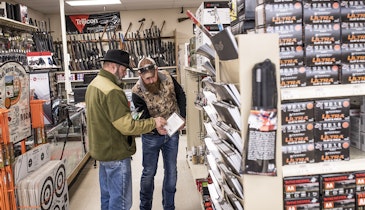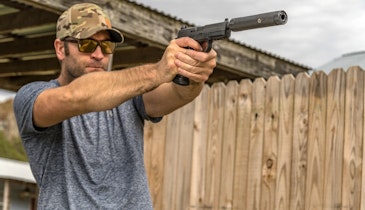
Built with demilitarized Israeli military parts and newly manufactured American parts, the American Tactical, Inc. Galeo is a hybrid copy of the Israeli Galil, a Kalashnikov pattern military arm. (Photo: Doug Larson)
The AK-47, and later the AKM, is widely believed to be the toughest and most reliable of all auto-loading carbines ever manufactured. It was designed to keep going with little maintenance. But one of its shortcomings is poor ergonomics. It is not particularly well suited for interface with the human body.
Then came the Galil, an Israeli-made carbine that attempts to solve the ergonomic problems of the AK while preserving the reliability and robustness of the design. After the Middle East’s Six-Day War of 1967, Israel examined several rifle designs looking for the best. The Kalashnikov AK-47 was selected, but then modified to fix perceived problems or short comings. The resulting Galil was chambered in 5.56x45mm NATO.
Although technically not a Galil, the Galeo made by American Tactical, Inc. (ATI) in Summerville, S.C., is based on the Galil and uses many Israeli military parts taken from Galils and imported for use on the Galeo. ATI uses newly machined American receivers and barrels, but mates them with used working parts taken from demilitarized Galils. The resulting firearm is a nice combination of new and used parts that, especially to the firearms enthusiast and historian, has a certain appeal that a mere Galil copy just can’t duplicate. Put one of these Galeos on your shop’s wall, and it is sure to draw customer attention.
Although parts are not interchangeable with a Kalashnikov, the Galil design clearly follows the AK-47 pattern. And many changes made by Israel were done to make the gun more user friendly.
Major Changes
A major design change was the charging handle. The Kalashnikov charging handle protrudes from the right side of the bolt carrier, which requires a right-handed user to either break the firing grip or reach over or under the gun with the left hand to operate it. Instead, the Galeo has a charging handle with a 90-degree upward bend that extends it just over the top of the dust cover so either a right- or left-handed shooter can retract the bolt without removing his or her hand from the pistol grip.
Another improvement is the safety selector. On a Kalashnikov, it is a stamped metal lever on the right side of the receiver. When pushed up, it prevents the bolt from being fully retracted and also blocks the trigger. The problem with it is that, for a right-handed shooter, it is not easily manipulated without removing the firing hand from the pistol grip. For a left-handed shooter, the support hand must be moved from the handguard.
To remedy this, the Israelis put a lever on the left side of the receiver where the pistol grip joins the receiver. This lever is mechanically connected to the safety lever on the right side of the receiver and, when one is moved, the other also moves — the left side lever can be manipulated with the firing hand without removing it from the grip. On a select fire Galil (the Galeo is semi-automatic only) the left side lever is moved forward for safe, in the middle for full auto and to the rear for semi-auto. Forward is safe and rear is fire on the Galeo.
The Israelis also improved the Kalashnikov iron sights by moving the rear sight from the front of the receiver to the rear of the dust cover. They also moved the front sight from the front of the barrel to the vicinity of the gas port. The result is a sight radius increase of about three inches. Additionally, the rear sight is an aperture instead of a notch. While the front sight is a post similar to the Kalashnikov’s and is adjustable for elevation by screwing it up or down, it is adjustable for windage by turning two opposing screws instead of drifting left or right. The front sight also bears witness marks to make adjusting for windage easier. The rear sight has two apertures, one marked for 300 meters and the other for 500 meters.
Another sight improvement is the addition of tritium vials for dim light, although the Galeo’s vials have been removed. To use the night sights, the rear apertures are rotated 45 degrees, taking both out of the line of sight and the rear notch is lifted. The large front post is then rotated to a position in back of the daylight post.
One potential drawback to situating the rear sight on the dust cover is that to clean the gun, the dust cover must be removed and replaced. This creates the possibility that the rear sight may not return to the same position. The dust cover on the Galeo is fitted much more snuggly than on a Kalashnikov and during evaluation I removed and replaced the dust cover and found there was no shift in point of impact at 50 yards.
How It Feels
The Galeo, with its recycled military parts, has a much more hand-filling pistol grip than does a Kalashnikov. It is very similar to the pistol grip found on an FAL. The trigger guard is generously sized so that a gloved finger should easily be able to press the trigger, which has a long but smooth take-up, followed by a clean break and generous over travel. The trigger pull weight on the sample gun measured 4 pounds, 14 ounces.
The magazine release on the Galeo is the Kalashnikov style paddle, but the Galeo’s paddle is protected by a shield that extends downward at the front of the trigger guard and prevents using a sweeping motion with a loaded magazine to remove an empty magazine. And, true to the Kalashnikov design, the bolt is not held back after the last round is fired.
The handguard is the square, blocky style designed by the Israelis and has a large channel in the bottom for stowage of a bipod. It’s not exactly an elegant handguard, but does allow plenty of air circulation for barrel cooling. No bipod is included, nor is a cleaning rod referenced in the owner’s manual. At the muzzle is a bird cage style flash suppressor.
The Galeo’s receiver was nicely machined, with no stray tool marks and was nicely finished in matte blue. The gun was equipped with a tubular folding stock that could be stowed to the right side of the receiver. When so folded, the gun could be fired in an emergency.
The Galeo is usually extremely reliable — when shooting, there were two failures to feed and those happened with two different types of ammo. In both cases, the bolt failed to strip a round from the magazine and instead caught the round in the middle, holding the bolt open and putting a big dent in the side of the cartridge case. The cause could be a faulty Tapco polymer Galil magazine, but only one is supplied with the gun, so it was impossible to test another magazine. Message to ATI: Come on, supply at least two magazines. The MSRP is about $1,300 after all, so you ought to be able to afford it.
Accuracy was acceptable for an iron-sighted semi-automatic gun of this style. ATI offers dealer support in several ways. Cooperative advertising money is available and ATI will train dealers on request. Payment terms are offered, and dealers can purchase guns wholesale from a number of national distributors. ATI also has, and enforces, a minimum advertised price policy to protect dealer margins.
SPECS
AMERICAN TACTICAL, INC. GALEO
Caliber: 5.56x45mm NATO
Barrel length: 18.5 inches and 1:7 twist
Overall length: 38.5 inches
Weight: 9 pounds unloaded
Stock: Folding tubular metal butt, polymer pistol grip, polymer handguard (wood available)
Sights: Windage- and elevation-adjustable front post, aperture rear
Action: Long-stroke gas piston, semi-automatic
Finish: Blued
Capacity: 30-round magazine
Price: $1,300





